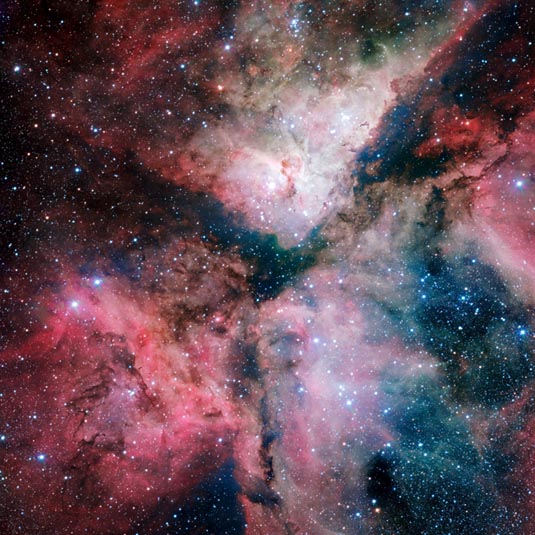
the VLT Survey Telescope
Emission Nebulae
RA 10h 45m 08.5s Dec -59° 52' 04?
Carina
~6500-10,000 light years
About 10 pc
ESO/ VPHAS+ Consortium/Cambridge Astronomical Survey Unit
December 6, 2012
Other: 2000 2007 2009a 2009b 2010 2011a 2011b 2012a 2012b 2018
ABOUT THIS IMAGE:
A spectacular new image of the star-forming Carina Nebula has been captured by the VLT Survey Telescope at ESO's Paranal Observatory and released on the occasion of the inauguration of the telescope in Naples today. This picture was taken with the help of Sebastián Piñera, President of Chile, during his visit to the observatory on June 5, 2012.
The VST is a state-of-the-art 2.6-meter telescope, with the huge 268-megapixel camera OmegaCAM at its heart. It is designed to map the sky both quickly and with very fine image quality. The VST is a joint venture between ESO and INAF and OmegaCam has been provided by the OmegaCam consortium. This new telescope is the largest telescope in the world exclusively dedicated to surveying the sky at visible wavelengths. The occasion of the inauguration has been marked by the release of a dramatic picture of the Carina Nebula taken with the new telescope.
This star formation region is one of the most prominent and frequently imaged objects of the southern sky. It has been the subject of many earlier images with ESO telescopes (eso1208, eso1145, eso1031, eso0905). However, the glowing gas cloud is huge and it is difficult for most large telescopes to study more than a tiny part of it at once. This makes it an ideal target for the VLT Survey Telescope and its big camera, OmegaCAM. The VST delivers very sharp images because of its high quality optics and the excellent site. But, as it was designed for surveys of the sky, it also has a very wide field of view that can take in almost all of the Carina Nebula in a single picture.
The Carina Nebula is a huge stellar nursery lying about 7500 light-years from Earth in the constellation of Carina (The Keel). This cloud of glowing gas and dust is one of the closest star formation regions to the Earth and includes several of the brightest and most massive stars known. The Carina Nebula is a perfect laboratory for astronomers studying the violent births and early lives of stars.
The
conspicuous red color of the picture comes from hydrogen gas in the nebula
that is glowing under the harsh ultraviolet light from many young and
hot stars. Other colors, originating from other elements in the gas, are
also visible, as well as many dust clouds. Just above the center of the
picture lies the bright star Eta Carinae. This huge and highly unstable
star brightened dramatically in the nineteenth century and is a good candidate
for a future supernova explosion.
From Wikipedia:
The
Carina Nebula (also known as the Great Nebula in Carina, the Eta Carina
Nebula, or NGC 3372) is a large bright nebula that surrounds several open
clusters of stars. Eta Carinae and HD 93129A, two of the most massive
and luminous stars in our Milky Way galaxy, are among them. The nebula
lies at an estimated distance between 6,500 and 10,000 light years from
Earth. It appears in the constellation of Carina, and is located in the
Carina-Sagittarius Arm. The nebula contains multiple O-type stars.
The nebula is one of the largest diffuse nebulae in our skies. Although
it is some four times as large and even brighter than the famous Orion
Nebula, the Carina Nebula is much less well known, due to its location
far in the Southern Hemisphere. It was discovered by Nicolas Louis de
Lacaille in 1751-52 from the Cape of Good Hope